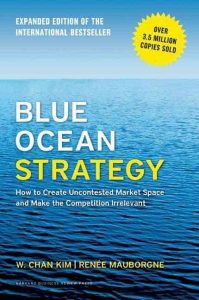The Blue Ocean Strategy was published in 2005 and authored by W. Chan Kim and Renée Mauborgne – Professors at INSEAD and co-directors of the INSEAD Blue Ocean Strategy Institute. So why has it taken so long to write a review for this book? It was clear from the outset that the authors were on to something special. But only time would prove whether or not they had created a new way to look at strategy or simply repackaged existing techniques and processes. The latest revised version of the book was published in 2015.
The central tenet of the Blue Ocean Strategy is to ‘create ″blue oceans″ of uncontested market space’. In other words to look at areas where your competition is not looking and and to provide extensions to your products or services to attack those markets. Easier said than done.
Blue Ocean Metaphor
Chan Kim and Mauborgne use the metaphor of red and blue oceans to describe the market. Red oceans represent the known market space. In a red ocean, an industry sector boundary is defined and accepted. Companies try to outperform each other and gain a greater share of product or service demand. As the market gets crowded, the prospect of profit and growth diminishes. Products and services become commodities and cutthroat competition turns the ocean bloody; hence, the term “red oceans”.
Blue oceans, in contrast, denote the uncontested market space. The market that does not yet exist. This market is untainted by competition. In blue oceans the demand is created so there is no need to fight over space. There is opportunity for growth that is both profitable and rapid. In blue oceans, competition is irrelevant because the rules of the game are waiting to be set. The market space is yet to be explored.
Blue Ocean Explored
The book is full of examples of successful Blue Ocean strategies which on face value are inspirational and helpful. However, when digging a bit deeper we can see that each of the businesses were quite special from the outset. Or they simply extended an existing business model to create a product/service differentiation rather than a new market space.
The classic example used in the first book and the extended version is Cirque du Soleil. The authors contend that Cirque du Soleil came about as an amalgam of three un-connected entertainment businesses (circus, theatre and dance) to create a new proposition that included the best of all three that created a new market space. This makes logical sense. The authors have since researched 100s of successful businesses and concluded that their success lay not in competing successfully but by making the competition irrelevant. The concept is compelling.
However, one could easily argue that a new market space has not been created. As with Cirque du Soleil and other examples such as Yellow Tail Wine and South West Airlines, these companies have simply differentiated themselves from the competition.The market spaces always existed, they were just not serviced very well.
Conclusion
Regardless of the view you might take, the real benefit of the Blue Ocean Strategy is the methodical approach of analysis that has been promoted by the authors. For this they should be applauded. Over the years they have created a huge amount of support material to help companies look at ‘Value Creation’ that is, reducing internal costs while increasing buyer value. Not least of which, they have introduced the Strategy Canvas, a simple methodology to compare a business to a benchmark or similar industry. The Strategy Canvas provides a highly visual tool to help look at future options. All in all, Blue Ocean Strategy is a book worth reading. You may or may not agree with the central philosophy, but you will be inspired.
Blue Ocean Strategy can be found on Amazon – Blue Ocean Strategy


